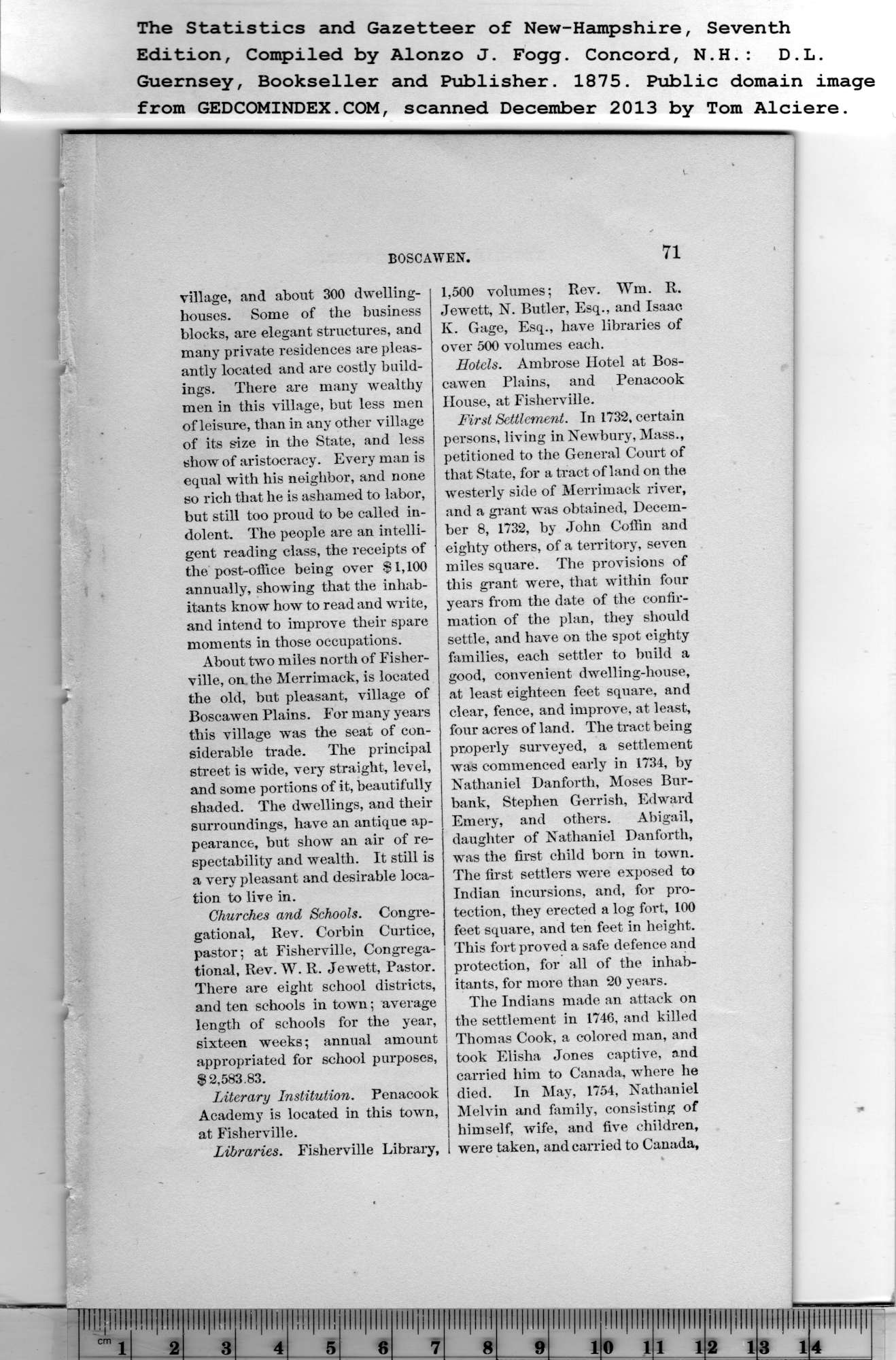|
village, and about 300 dwelling-
houses. Some of the business
blocks, are elegant structures, and
many private residences are pleas-
antly located and are costly build-
ings. There are many wealthy
men in this village, but less men
of leisure, than in any other village
of its size in the State, and less
show of aristocracy. Every man is
equal with his neighbor, and none
so rich that he is ashamed to labor,
but still too proud to be called in-
dolent. The people are an intelli-
gent reading class, the receipts of
the post-office being over $1,100
annually, showing that the inhab-
itants know how to read and write,
and intend to improve their spare
moments in those occupations.
About two miles north of Fisher-
ville, on the Merrimack, is located
the old, but pleasant, village of
Boscawen Plains. For many years
this village was the seat of con-
siderable trade. The principal
street is wide, very straight, level,
and some portions of it, beautifully
shaded. The dwellings, and their
surroundings, have an antique ap-
pearance, but show an air of re-
spectability and wealth. It still is
a very pleasant and desirable loca-
tion to live in.
Churches and Schools. Congre-
gational, Rev. Corbin Curtice,
pastor; at Fisherville, Congrega-
tional, Rev. W. R. Jewett, Pastor.
There are eight school districts,
and ten schools in town; average
length of schools for the year,
sixteen weeks; annual amount
appropriated for school purposes,
$2,583.83.
Literary Institution. Penacook
Academy is located in this town,
at Fisherville.
Libraries. Fisherville Library, |
71
1,500 volumes; Rev. Wm. R.
Jewett, N. Butler, Esq., and Isaac
K. Gage, Esq., have libraries of
over 500 volumes each.
Hotels. Ambrose Hotel at Bos-
cawen Plains, and Penacook
House, at Fisherville.
First Settlement. In 1732, certain
persons, living in Newbury, Mass.,
petitioned to the General Court of
that State, for a tract of land on the
westerly side of Merrimack river,
and a grant was obtained, Decem-
ber 8, 1732, by John Coffin and
eighty others, of a territory, seven
miles square. The provisions of
this grant were, that within four
years from the date of the confir-
mation of the plan, they should
settle, and have on the spot eighty
families, each settler to build a
good, convenient dwelling-house,
at least eighteen feet square, and
clear, fence, and improve, at least,
four acres of land. The tract being
properly surveyed, a settlement
was commenced early in 1734, by
Nathaniel Danforth, Moses Bur-
bank, Stephen Gerrish, Edward
Emery, and others. Abigail,
daughter of Nathaniel Danfortli,
was the first child born in town.
The first settlers were exposed to
Indian incursions, and, for pro-
tection, they erected a log fort, 100
feet square, and ten feet in height.
This fort proved a safe defence and
protection, for all of the inhab-
itants, for more than 20 years.
The Indians made an attack on
the settlement in 1746, and killed
Thomas Cook, a colored man, and
took Elisha Jones captive, and
carried him to Canada, where he
died. In May, 1754, Nathaniel
Melvin and family, consisting of
himself, wife, and five children,
were taken, and canned to Canada, |
